
Jules Lavirotte: a new version of the book is published by the Cercle Guimard — an exhibition is dedicated to him in Évian — the building of the Châtelet mineral water company
9 May 2025
In 2018, the Jules Lavirotte Association published its first book dedicated to the life and work of an architect whose fame is paradoxical: although his name and some of his works are well known to the public, his life and career were virtually unknown even to specialists. This year, authors Yves Lavirotte and Olivier Barancy chose the Cercle Guimard for the publication of a revised and expanded edition of the book. Although the first version—now out of print—was remarkable, this new edition surpasses it. In 192 pages with numerous illustrations, the authors complete the architect’s career with previously unpublished information and new works. The book is available since the end of May 2025 at a price of €35. Its publication will be followed by a book signing and guided tours dedicated to Lavirotte’s work, events which we will come back to shortly.
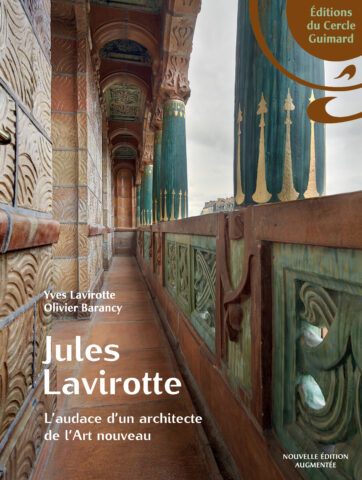
To mark the launch of this new edition, the authors have seized the opportunity of an exhibition dedicated to the architect, organized with their assistance by the city of Évian at the Villa du Châtelet, from June 1 to September 30, 2025.
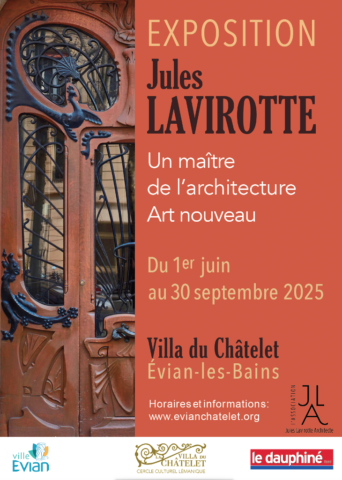
Olivier Barancy tells us the story of the thermal baths built in Évian by Lavirotte, of which the Villa du Châtelet is one of the remaining buildings.
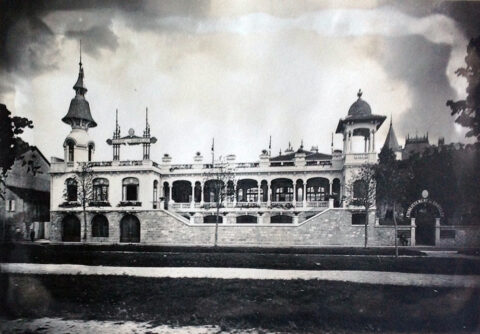
General view of the refreshment bar, lake side, old photograph. Private collection
Following the acquisition on April 4, 1906, by Arthur Sérasset and Émile Lavirotte of land built on the shores of Lake Geneva in Évian-les-Bains, Jules Lavirotte was approached by his brothers to build a spa on the newly acquired land. The architect immediately set to work and construction began quickly.
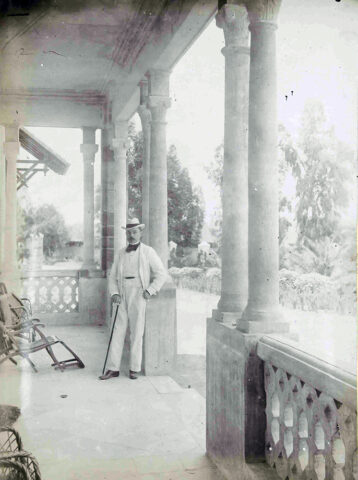
Jules Lavirotte in a gallery of the refreshment bar, old photographic print. Private collection.
The project is significant: on a sloping plot of approximately 15,000 square meters, with a length of over 100 meters along a busy road that runs alongside the lake, a new building, the “buvette,” is to be constructed at 29 Quai Paul-Léger. This will incorporate a small, recently built (1898) neo-Renaissance villa with a charming layout. A patio designed by the architect will connect the new building to the existing part, which will house the offices. The refreshment bar included all the facilities necessary to welcome spa guests, as well as commercial services linked to the offices. In addition, two existing villas, including the one known as the Châtelet, which gave its name to the spa complex, were converted to accommodate spa guests, along with the service building and the gardener’s house at the top of the park, which housed the staff. The refreshment bar, in late Art Nouveau style, is spread over three levels. The ground floor houses the commercial bottling area, including a covered unloading bay and services. The first floor comprises, on the lake side, a large gallery with paired columns, flanked by a reading room and a large lounge; and on the south side, opposite the lake, a “luxuriously appointed refreshment room” connected to a “lunchroom.” The whole building is covered by reinforced concrete terraces accessed by a staircase sheltered in a graceful bell tower on the west side of the facade. To the east and at the opposite corner, another bell tower, with a slender silhouette, rises to a height of 16 meters. These two structures make the building visible from afar, in accordance with an architectural technique commonly used in the design of public buildings. The interior design is luxurious: a large stained-glass window[1] at the end of the south gallery depicts a landscape of snow-capped mountains with a stream flowing down from them; the walls are decorated with antique-style frescoes depicting fountains and garlands; and from the ceiling hang chandeliers with golden branches, decorated with three-tone leaves and clusters of Murano glass[2]; Finally, mosaics cover the floor. In the park, a stream winds its way between rockeries and flows through a rustic kiosk, where water from a second spring also flows, behind the “châtelet.” The establishment was inaugurated at the end of 1910.
Françoise Breuillaud-Sottas, a specialist in thermalism in Évian, highlighted the originality of the project: “Only the Châtelet spring is associated with a genuine hydrotherapy establishment.”
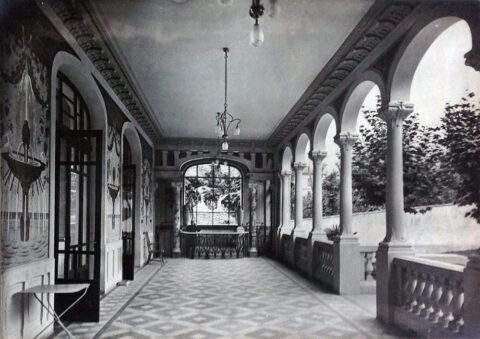
A gallery in the refreshment bar, overlooking the park, featuring old photographic prints. Private collection.
At the same time, Arthur Sérasset, administrator of the Société des Sources du Chatelet and partner of Émile Lavirotte, gave Jules Lavirotte “full powers” to find and fit out shops in Paris to sell the bottles of mineral water. He opened at least two, at 36 Boulevard des Italiens and 56 Boulevard de Bercy. The finishings of the refreshment bar appear to have been carefully executed, as some of the contractors were the same as those who worked on the mansion on Avenue de Messine in Paris. Finally, in 1909, the architect designed the Office des Baigneurs (bathers’ office) at 4 Avenue du Port in Évian. It was a modest premises for a real estate agency, which also owned the newspaper Évian Mondain.
However, the additional commission for the construction of the grand hotel overlooking the park was difficult to obtain, as the shareholders’ meeting criticized Lavirotte for his lack of follow-up on the first building and for exceeding the budget. They demanded the presence of an assistant architect on site: this was Étienne Curny (1861-1945), who was active in Lyon and the surrounding region. The main features of the project drawn up in 1907 were more traditional than the refreshment bar, although the large terrace overlooking the lake, the bold canopy over the south entrance, and the floral friezes surrounding the building under the attic were noteworthy. However, at the request of the clients, the plans were significantly modified to reduce costs and increase the number of rooms. The north façade in particular, with its balconies, two avant-corps, and an asymmetrical slate roof, bears little resemblance to the initial sketch. Lavirotte ultimately withdrew from the project.
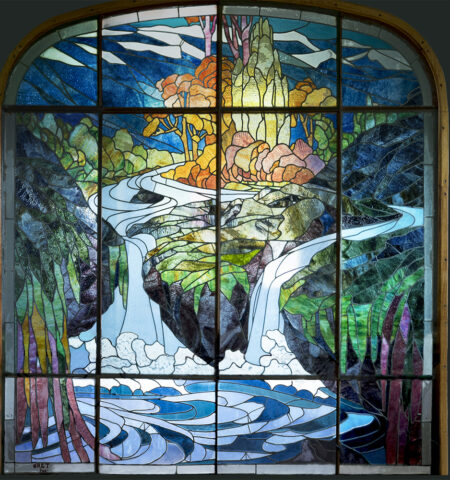
Auguste Labouret, large stained glass window in the refreshment bar, on the park side.
Photo by Christophe Lavirotte.
In 1925, a scandal erupted around the water from the Évian-Châtelet springs: its managers, including its president, Mr. Bocheux, were sentenced to several months in prison for selling mineral water that did not meet health standards. The following year, the Hôtel du Châtelet was renamed the Hôtel du Parc. Then, in 1938, the refreshment bar was demolished[3] to make way for a road connecting the quay to the hotel where, on March 18, 1962, the Évian Accords were signed, ending the Algerian War.
Olivier Barancy
Notes
[1] Designed by Auguste Labouret (1871-1964), a prolific master glassmaker based in Paris.
[2] Jules Lavirotte went to Venice himself to choose them.
[3] Some elements were preserved and displayed in the park.
Translation: Alan Bryden
